“Dakota” means “friend.” Thousands of people made up The Great Dakota Nation.
They occupied parts of Minnesota, South Dakota and other areas west of the Mississippi River.
The Chippewa Indians, enemies of the Dakota, called them “adders” (an adder is a type of snake). When the French traders tried to say this word in the Chippewa language, they could not say it correctly and it came out sounding like “Sioux” (soo). This name became commonly used for people of The Great Dakota Nation.
The Chippewa had made friends with the French who gave them guns and helped them in their battles. In time, the Chippewa began pushing the Sioux people out of Minnesota and into North Dakota.
The Great Dakota Nation—Lakota, Nakota, Dakota
The Great Dakota Nation was divided into three separate groups, each having its own culture and language patterns. The three groups were the Lakota (or Teton), Nakota (or Yankton), and Dakota (or Santee). A large northern area west of the Mississippi River was named after The Great Dakota Nation. It was called Dakota Territory.

The Great Dakota Nation (about 1822) consisted of three separate groups—the Lakota (or Teton), Nakota (or Yankton), and Dakota (or Santee). SHSND-ND Studies.
The largest group of the Great Dakota Nation was the Lakota Sioux, who were made up of seven major tribes. The Lakota people were taller than most other people at that time. Many of their warriors were over six feet in height.
The Lakota became expert horsemen. Hunting bison was their main source of livelihood, but they also raided other tribes to get more horses and other items that they wanted. They claimed a very large hunting area ranging hundreds of miles from Oklahoma into Canada. All of the Sioux tribes were nomadic, but the Lakota were the most nomadic of the three groups of The Great Dakota Nation.
The Dakota Sioux moved into North Dakota from Minnesota after conflicts and battles with both white settlers and U.S. soldiers. Four tribes made up the Dakota group.
Like the Lakota, the Dakota traveled long distances on horseback to hunt and to raid other tribes. The nomadic tribes lived in tipis, so it was easy for them to pack and move to another place when the bison herds would move on.
The Nakota Sioux were pushed west by the Chippewa. They were divided into two tribes that settled in South Dakota and the southern part of North Dakota. Many of them built permanent homes like the ones they had left in Minnesota. Hunting bison became a central part of their lives, but many people also raised corn, squash, and other vegetables.
The nomadic tribes lived more out in the open than the tribes who lived close together in permanent villages. For this reason, when the smallpox epidemics came, the disease did not spread among the Sioux as much as it spread throughout the agricultural people in villages. In fact, when the Mandan and Hidatsa were losing thousands of people to smallpox, Sioux warriors raided the villages and killed even more people.
The Indians of The Great Dakota Nation had been woodland people who had hunted, fished, and sometimes farmed. When they moved to the plains, they had to change their way of life from a woodland culture to a plains culture.
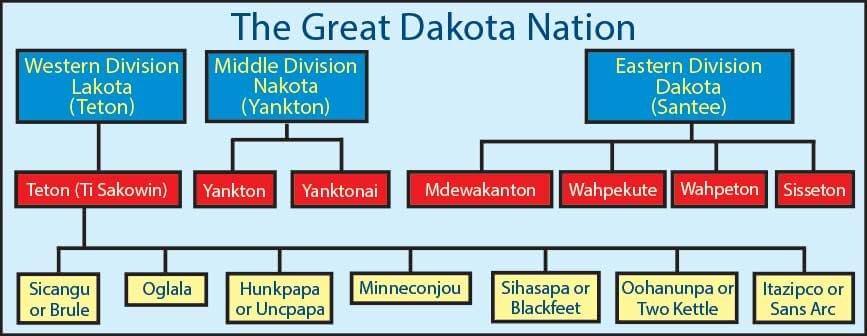
Chart shows the 3 major divisions of the Great Dakota Nation, and how each is then also split into bands. SHSND-ND Studies.
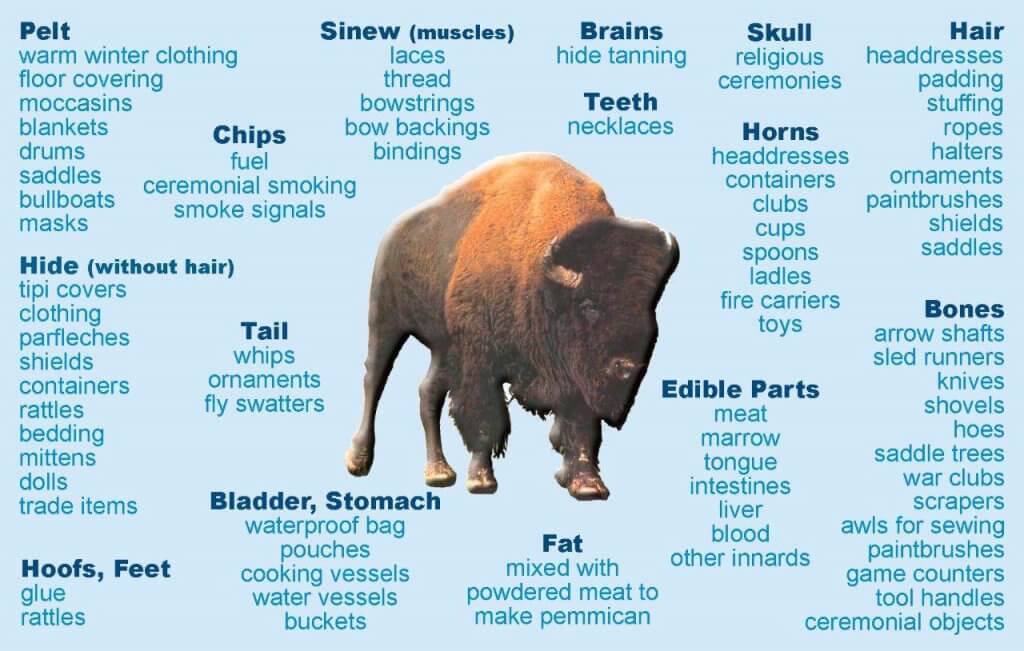
The bison provided food, shelter and clothing, as well as skulls and bones for religious ceremonies of the Plains Indians,. Some called the animal “A Walking Department Store.” SHSND-ND Studies.
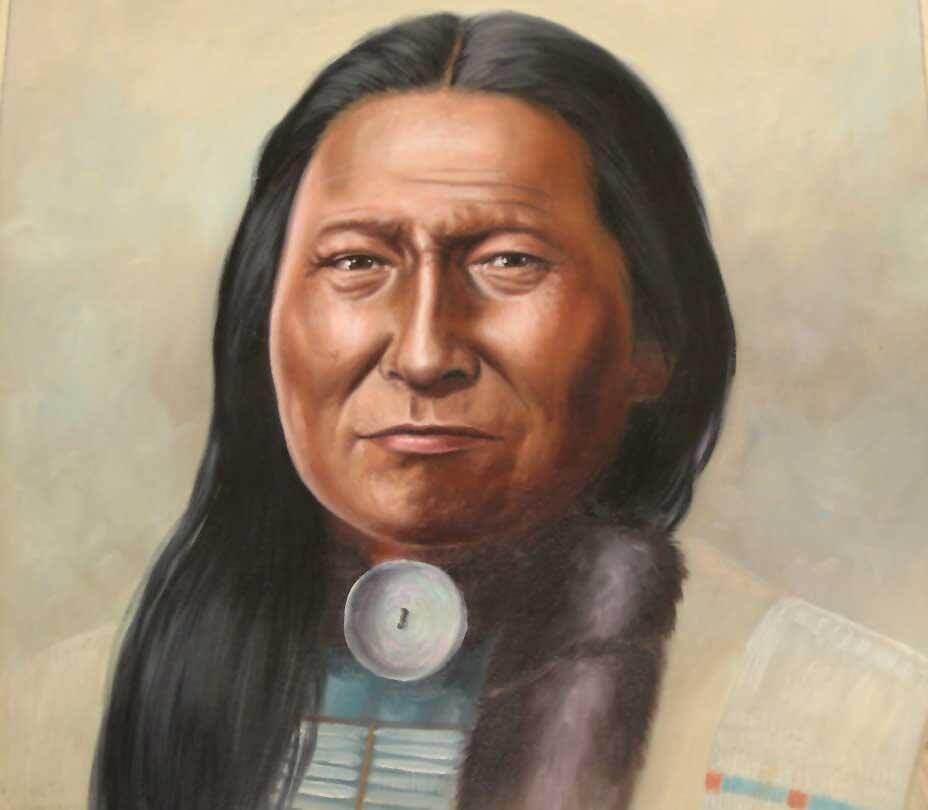
Chief Rain-in-the-Face was a traditional Lakota leader from the Standing Rock Sioux Nation. He was a brave warrior who stood firm to prevent the senseless killing of bison and other game. Rain-in-the-Face was also a key leader at the Battle of the Little Bighorn in 1876. (Standing Rock Sioux Tribal Council)
Millions of bison lived on the plains and these huge animals were very different from the forest animals that had been hunted in the woodlands of Minnesota. In fact, the survival of the plains people depended on hunting bison. They used every part of the animal, not wasting anything. The bison has been called “a walking department store” because so many items came from this animal. Food, shelter, clothing, weapons, tools and musical instruments are a few examples of products that were made from the bison.
Millions of years ago, tiny, three-toed horses lived in North Dakota. They became extinct millions of years before modern horses arrived. Modern horses did not live on the continent of North America until people from Spain brought them to the southern part of the continent in the 1500s.
They slowly spread northward as they were traded from tribe to tribe until the horses reached North Dakota toward the end of the 1700s. After the Indians got horses, they were able to travel long distances which made the bison hunting much easier.
It has been estimated that before 1800 about [30 million] bison roamed the plains. The Sioux, as well as all of the other Indians of the plains, had lived for many years being totally dependent on the bison.
Because North America was the only continent where bison lived, Europeans had never seen such an animal. When traders began sending bison robes to Europe, the robes became so popular that the traders could not keep up with the demand.
In the 1800s, millions of bison were killed. Bison hide traders, farmers, railroad companies, sport hunters, and the U.S. Army all had a part in reducing the bison herds. Wagon load after wagon load of bison robes were hauled away to be sold in the east or shipped to Europe. Farmers wanted the bison gone so that they could raise crops and build fences for their cattle. Railroads were being built across the continent, and the railroad companies wanted to bring in more settlers so that they would get more business.
Bison herds were in the way of settlement, so railroads hired people to shoot the animals. The U.S. Army wanted the Indians’ food supply removed so that the Indians would move to reservations. Hunters came from the east to shoot bison just for sport. Most of the bison meat and other parts were wasted by these whites.
Because of all of these wasteful killings, the magnificent bison became almost extinct. It has been estimated that by 1890, only about 500 bison remained in North America.
The loss of their food supply led to the defeat of the Lakota and other plains tribes. The bison had not only served as the source of their food, but it had also been a sacred animal for them. With its disappearance, they lost a great source of their spiritual strength.
Sitting Bull
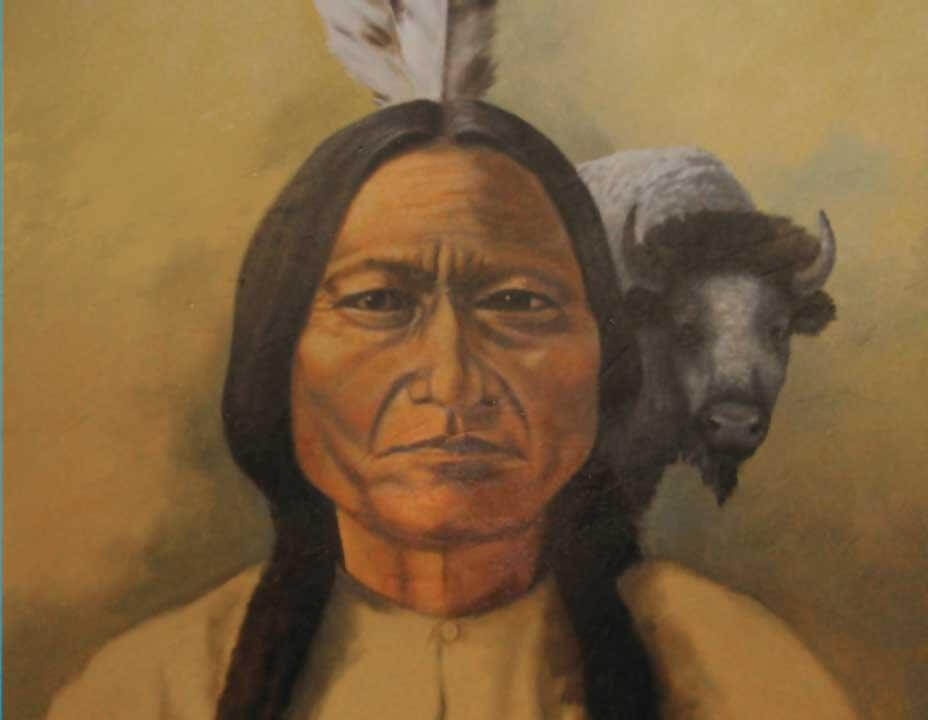
Sitting Bull. Photo Standing Rock Sioux Tribal Council.
Sitting Bull was a Lakota leader and medicine man who became one of the most famous American Indians in the world. He was born around 1831. When he was about 14 years old, he proved his bravery in a battle, and that was the beginning of his career as a warrior.
Sitting Bull was the leader of the Hunkpapa band of the Lakota and widely respected leader in the Lakota Nation.
Sitting Bull’s goal was to protect his people and their lands from “whites” who were moving onto Indian lands and killing off the bison. In 1876, Lakota and Cheyenne families gathered at the Little Big Horn River in Montana. In June, army troops led by George Custer from Fort Abraham Lincoln (near present-day Mandan, North Dakota) attacked, but the Lakota warriors defeated Custer’s army, killing Custer and most of his soldiers.
After Custer’s defeat, the U.S. Army began attacking all Indians who were not on reservations. Sitting Bull led his followers to Canada for safety. In 1881, Siting Bull surrendered to save his people from starvation. He and his people were sent to the Standing Rock Sioux Reservation.
Sitting Bull became famous because of the battle with Custer, so he was asked to join “Buffalo Bill’s Wild West Show.” He agreed because he wanted to earn money to help his people. He stayed with the “Wild West Show” for four months and earned good pay, but he missed his home and family at Standing Rock.
A few years after Sitting Bull returned to Standing Rock Reservation, a new religion called the “Ghost Dance” came to the Lakota. Ghost Dancers believed that if they danced and followed the beliefs of the Ghost Dance that the bison would return.
The reservation agent feared the power of the Ghost Dance and Sitting Bull’s influence on the unhappy Lakota. The agent sent Indian police to arrest Sitting Bull. His followers resisted and there was a fight. Sitting Bull was shot and died.
Sitting Bull is honored today as one of the greatest leaders of the Lakota Nation.
Chippewa

Birch-bark canoe. The Chippewa used the birch-bark canoe for fishing and travel. SHSND 053-04.

A Chippewa/ Métis family shown with a Red River cart. Red River carts were equipped with high wheels that traveled well on prairie sod, similar to the peasant carts the fathers and grandfathers had known in France. SHSND A2472-2.

Map of Red River cart trails hauling their bison hides and pemmican to Winnipeg and St Paul for trading. SHSND-ND Studies.
The Chippewa, or Ojibwa, people came to North Dakota from the forests of Wisconsin and Minnesota. They lived in wigwams most of the time, but during the summers when they hunted bison, they used tipis, which could be set up and taken down quickly.
The Chippewa were good fur trappers and traveled along rivers to trap beaver for trade with Euro-Americans. They used the birch-bark canoe for fishing and traveling on rivers and lakes. These canoes had high ends and sides so that even in rough or choppy water, the water did not come in easily. Birch-bark canoes were very strong, but they were light enough to be carried on land.
The Chippewa Indians organized themselves into groups called “bands,” which were named after the area in which they lived. A main chief led each band, and he was assisted by lesser chiefs.
A tribal council made sure the chiefs were carrying out their duties. After the death of the main chief, his son would take over and act as chief for the rest of his life. However, if the chief was not doing his job properly, the council could replace him with someone else.
Each band was divided into “clans,” named after animals, birds, or fish. The clans were made up of several families who seemed like one big family. They would look after each other and help each other out. People were not allowed to marry anyone in their own clan.
Before 1800, groups of Chippewa had come to eastern North Dakota. These people trapped and traded in the Pembina area, so they called themselves the Pembina Band.
After a few years, so much trapping had been done in eastern North Dakota that the population of fur-bearing animals was very low. In order to be successful in their business, the Chippewa needed to move farther west.
A group settled in the Turtle Mountains and called themselves the Turtle Mountain Band. In this hilly region of lakes and trees, animals such as fish, beaver, muskrat and deer were plentiful.
Because the Chippewa had gotten horses in the early 1800s, they were also able to hunt bison successfully. The Chippewa not only continued their commerce at the Pembina trading post, but they could also travel great distances to trade with other tribes. The Chippewa people adapted well from the woodlands to the plains.
Many Chippewa women married French or Scottish fur traders. Their children, who were half Chippewa and half French or Scottish, were called Métis (may-tee).
The Métis people usually thought of themselves as Indian, but their culture was a mix of Indian and European traditions. They were known as good bison hunters and fur traders. They developed a two-wheeled cart pulled by oxen or horses. These carts were called Red River carts.
They could carry huge amounts of bison hides and other goods to major trade centers such as St. Paul, MN and Winnipeg, Manitoba.
During the late 1800s, the Turtle Mountain Band faced many hardships. Euro-American settlers were moving onto Chippewa lands, and the bison, the Chippewa’s main source of food, became almost extinct on the plains.
During the winter of 1887–88, over 150 members of the Turtle Mountain Band of Chippewa starved to death.
Reservations in North Dakota
The Standing Rock Sioux Reservation is home to Lakota and Dakota Sioux people. The reservation was set up for the Standing Rock Sioux Tribe in 1889. Before that, it was part of a large reservation that was broken up by the government to allow for white settlement.
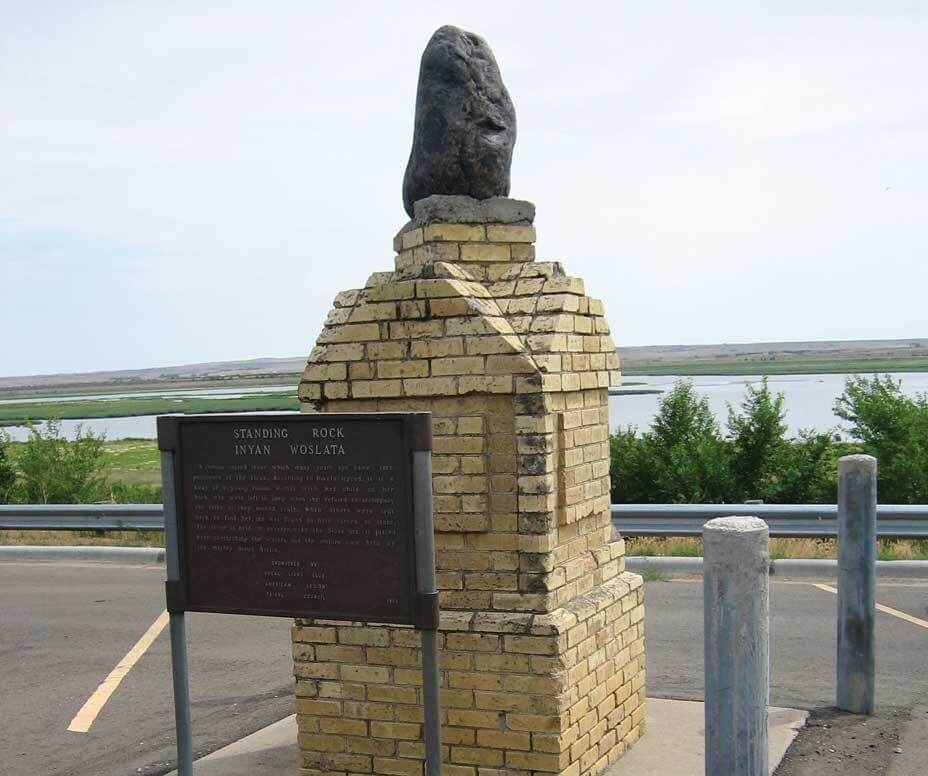
Standing Rock Monument is located near the entrance to the Standing Rock Tribal headquarters in Fort Yates, North Dakota. Neil Howe.
The Standing Rock Sioux Reservation is located about 40 miles south of Mandan ND and extends into South Dakota. The ND part of this reservation is located almost entirely in Sioux County, the only county in the state that is entirely reservation. Most of the land has rolling hills and grasslands that are good for ranching and farming.
The Cannonball River runs along the north side of the reservation and Lake Oahe on the Missouri River forms the eastern boundary. Lake Oahe was created when a dam was built in South Dakota on the Missouri River.
The dam was finished in 1962 and 50,000 acres of fertile bottomland and timber were permanently flooded when the lake was formed. Today, Lake Oahe attracts tourists as a water recreation area. Many picnic areas and campgrounds are available near the lake.
The tribal headquarters of the Standing Rock Sioux Reservation is at Fort Yates. Most of Fort Yates is situated on a peninsula of Lake Oahe.
Two tourist attractions at Fort Yates are Sitting Bull’s gravesite and the Standing Rock monument. An old Dakota story said that an Arikara woman married a Dakota man. This man later married another woman and the first wife got jealous.
When the rest of the band left the camp, she refused to leave. Two men who came back to get her found that she had turned to stone. The Standing Rock monument reminds people of this story.
Fort Yates is also the location of Sitting Bull College. This college, which was first called “Standing Rock Community College,” began offering classes in 1973. It now offers four-year college degrees.
Farming and ranching are the major means of support on the Standing Rock Sioux Reservation, but several hundred people are also employed by the tribe.
Prairie Knights Casino and Resort is a successful tribal business. It consists of an entertainment center, hotel, RV park and other attractions that bring people to the area.
In spite of these opportunities, the Standing Rock Sioux Reservation still has a shortage of jobs, so many people struggle to make a living. Many tribal members have left the reservation to find better jobs.
It is important to the Sioux people that their children receive a good education, including being taught their traditional language and culture. The elders share the rich traditions that have been handed down to them and the young people can carry these gifts into the future with pride.
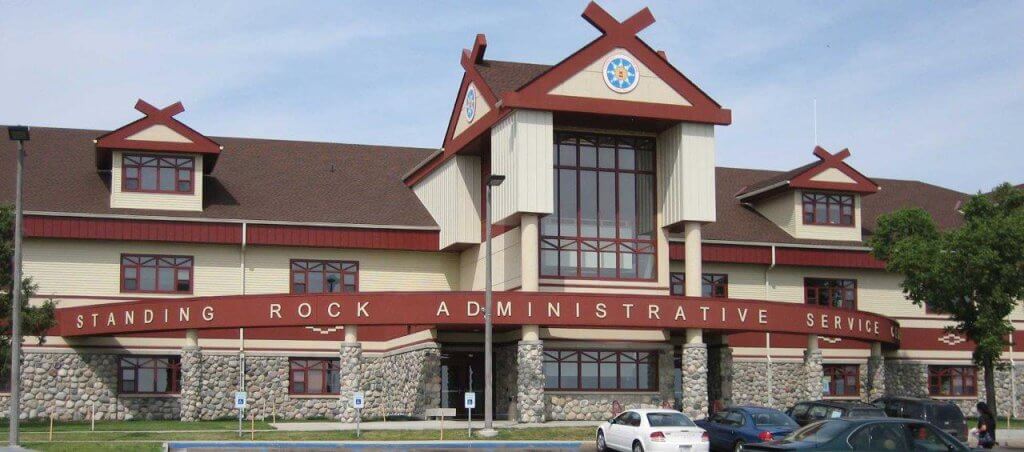
Tribal Headquarters building for the Standing Rock Sioux at Fort Yates ND. Neil Howe.
Josephine Gates Kelly

Josephine Gates Kelly was the first woman in US to be elected Tribal Chair. SHSND 1952-5040.
Josephine Gates Kelly believed she could make a difference in the lives of the Indian people, and she became an outstanding leader. Her goal was to help her people, which she did, but she also made history.
Josephine Gates was born January 24, 1888, and was raised on the Standing Rock Sioux Reservation. She was the first woman from Standing Rock to graduate from Carlisle (car-lyl) Indian School in the state of Pennsylvania. She married Covin Kelly in 1920, and they had six children.
In 1940, Josephine was elected to the Standing Rock Tribal Council. Her leadership abilities were so good that in 1946 she won an election that made history. Josephine Gates Kelly became the first woman in the United States to be elected Tribal Chair.
The U.S. government had planned on putting the Standing Rock Indian agency together with another Indian agency, but the Standing Rock Tribe opposed this action. They thought it would weaken their tribal rights.
Tribal Chair Josephine Gates Kelly traveled to Washington, DC to fight for fair treatment of the Standing Rock Tribe. She was successful in her efforts and the Standing Rock Tribe was able to keep their rights.
In the early 1950s, Josephine helped establish a memorial for Indians killed while serving in the United States Armed Forces. This memorial is located in Valley Forge, Pennsylvania.
After serving three terms as Tribal Chair, Josephine Gates Kelly remained active in politics and government. She worked for the rights of not only the Standing Rock Sioux Tribe, but for all Indians, and earned the nickname “Champion for Indian Rights.” She died in 1976.
Turtle Mountain Reservation
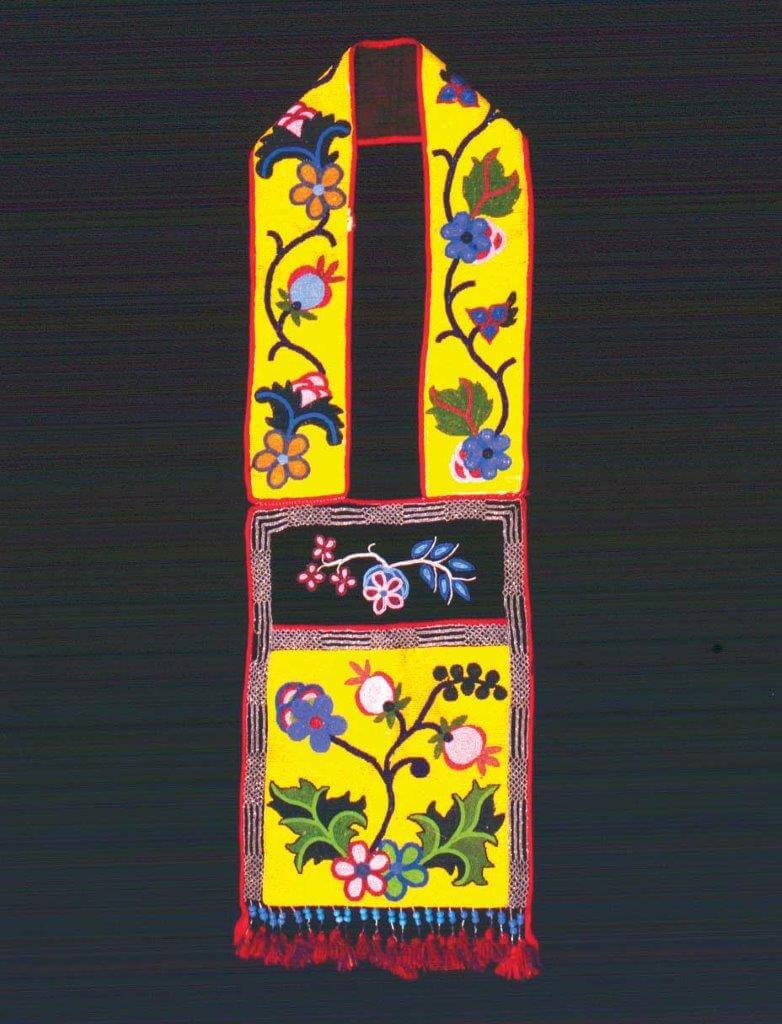
A Chippewa bandolier. Warriors wore the bandolier across the shoulders and used the pockets to carry ammunition. SHSND 870.
The Turtle Mountain Reservation is home to the Turtle Mountain Band of Chippewa. Located in the Turtle Mountains near the Canadian border, it is close to the International Peace Garden.
The land in this region was shaped by glaciers which left rolling hills and many lakes and streams. The area also has a lot of trees.
A treaty was signed in 1863 that established the Turtle Mountain Reservation. In 1882, the size of the reservation was reduced to a rectangular area measuring just 12 miles east-to-west by 6 miles north-to-south.
The US government had not counted the Métis as part of the Chippewa population at that time, so the reservation was much too small. In order to meet the needs of all the people, an area about 250 miles west of the Turtle Mountain Reservation was later established.
This region is called the “Trenton Service Area” and provides services mostly for Chippewa and Métis people. Part of this Indian service area extends into Montana.
In Canada, the Métis are considered a separate tribe, but in North Dakota they are part of the Turtle Mountain Band of Chippewa.
Through the years, many of the Métis developed their own lifestyles which blended parts of both the Indian and the French cultures. They dressed in a combination of Indian and European clothing and their language was influenced by both of their cultures.
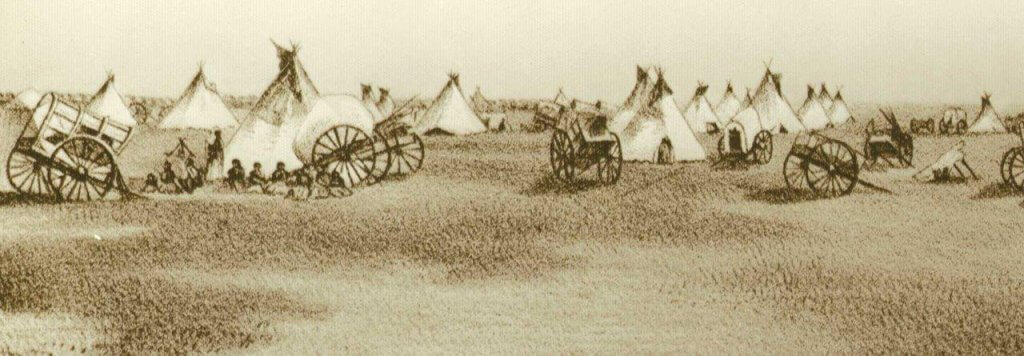
Sketch of a Métis campsite. Notice the Red River carts with their two large wheels next to each tipi. SHSND C0621.
Dream Catcher
An ancient Chippewa tradition
The dream net has been made
For many generations
Where spirit dreams have played.
Hung above the cradleboard,
Or in the lodge up high,
The dream net catches bad dreams,
While good dreams slip on by.
Bad dreams become entangled
Among the sinew thread.
Good dreams slip through the center hole,
While you dream upon your bed.
This is an ancient legend,
Since dreams will never cease,
Hang this dream net above your bed,
Dream on, and be at peace.
The only town on the Turtle Mountain Reservation is Belcourt, the largest Indian community in North Dakota. The tribal headquarters of the Turtle Mountain Band of Chippewa is located in Belcourt. Many Turtle Mountain Chippewa live in other towns nearby.
The Turtle Mountain Chippewa Indian Heritage Center near Belcourt is a museum complex which features displays showing the history and special culture of the Turtle Mountain Band of Chippewa Indians.
Besides the exhibits, articles are offered for sale, including craft and beadwork items, as well as supplies for arts and crafts. A library and outdoor cultural park are also part of this complex.
The well-educated and hard-working Chippewa own many successful businesses both on and off the reservation. The Belcourt area is home to Turtle Mountain Community College, a manufacturing plant, a watch factory, a shopping mall, a hospital, and other businesses.
Sky Dancer Casino and Resort is an entertainment center that includes a hotel and a restaurant. The second oldest Indian-owned radio station in the United States, 88.5 FM Public Radio (KEYA), is located in Belcourt.
Louise Erdrich
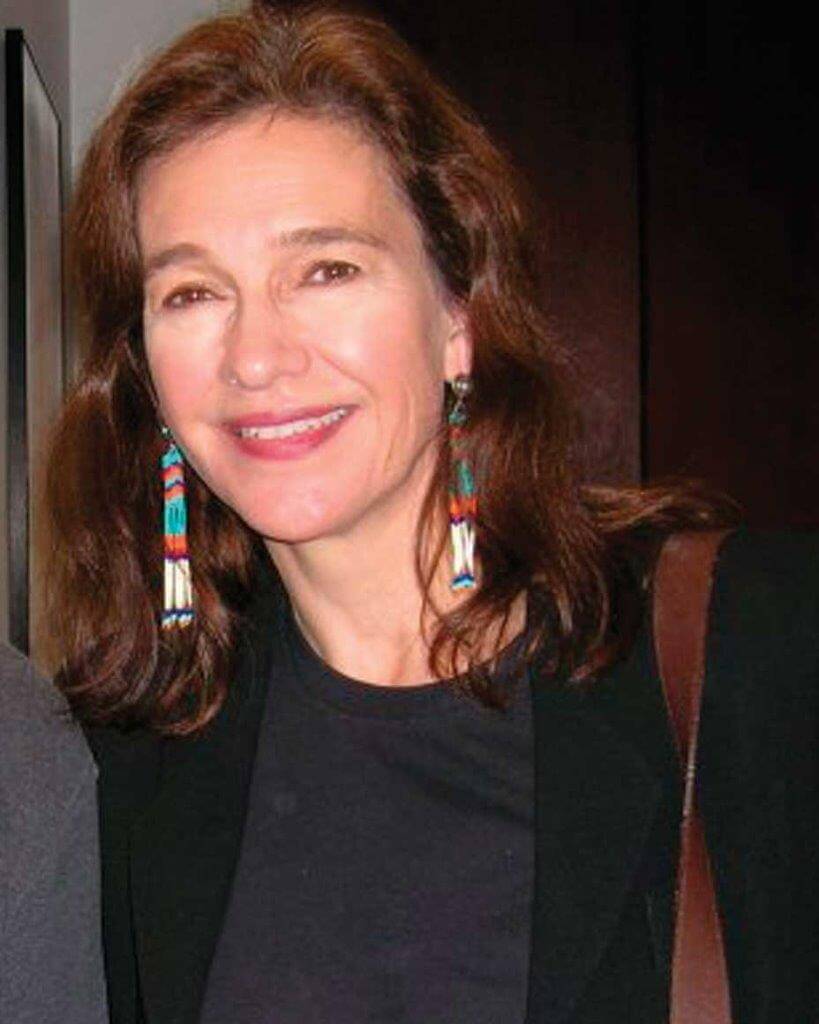
Louise Erdrich, noted author. www.eyeonbooks.com
Louise Erdrich (air-drik) is one of the most famous authors of our time. She was born in 1954 to a Chippewa mother and a German-American father. Her grandfather had been a tribal chair on the Turtle Mountain Reservation. Louise is a member of the Turtle Mountain Band of Chippewa.
When Louise was young, she heard so many stories told by her large extended family that she became interested in writing stories. Her parents liked her stories so much that her father paid her a nickel for every story she wrote, while her mother made covers for her “books” out of construction paper.
After growing up in Wahpeton, North Dakota, Louise went to the East Coast to attend college. She continued with her writing but also worked at other jobs in order to make a living. She has worked as a waitress, lifeguard, construction flag person and poetry teacher at a prison. She also taught writing to young people.
Louise was married and is the mother of six children. She used her background to blend Indian concerns into her magazine articles, poems and books. Her books became popular and she was able to devote all of her time to writing. Many of her books deal with serious issues, but Louise still blends humor into her writings.
She has stated that because Indian people have such a great sense of humor, it is one of the most important parts of American Indian life and literature.
Today, Louise Erdrich is a successful author who has written many award-winning books. Some of the most famous ones include Love Medicine, The Beet Queen, and The Bingo Palace. She also has authored a children’s book called Grandmother’s Pigeons.
In 2013 Louise Erdrich was presented with the Theodore Roosevelt Roughrider Award. The award recognizes present and former North Dakotans for their contributions to the state.
Further study, activities:
https://www.ndstudies.gov/curriculum/4th-grade/american-indians-nd
#

Francie M Berg
Author of the Buffalo Tales &Trails blog


